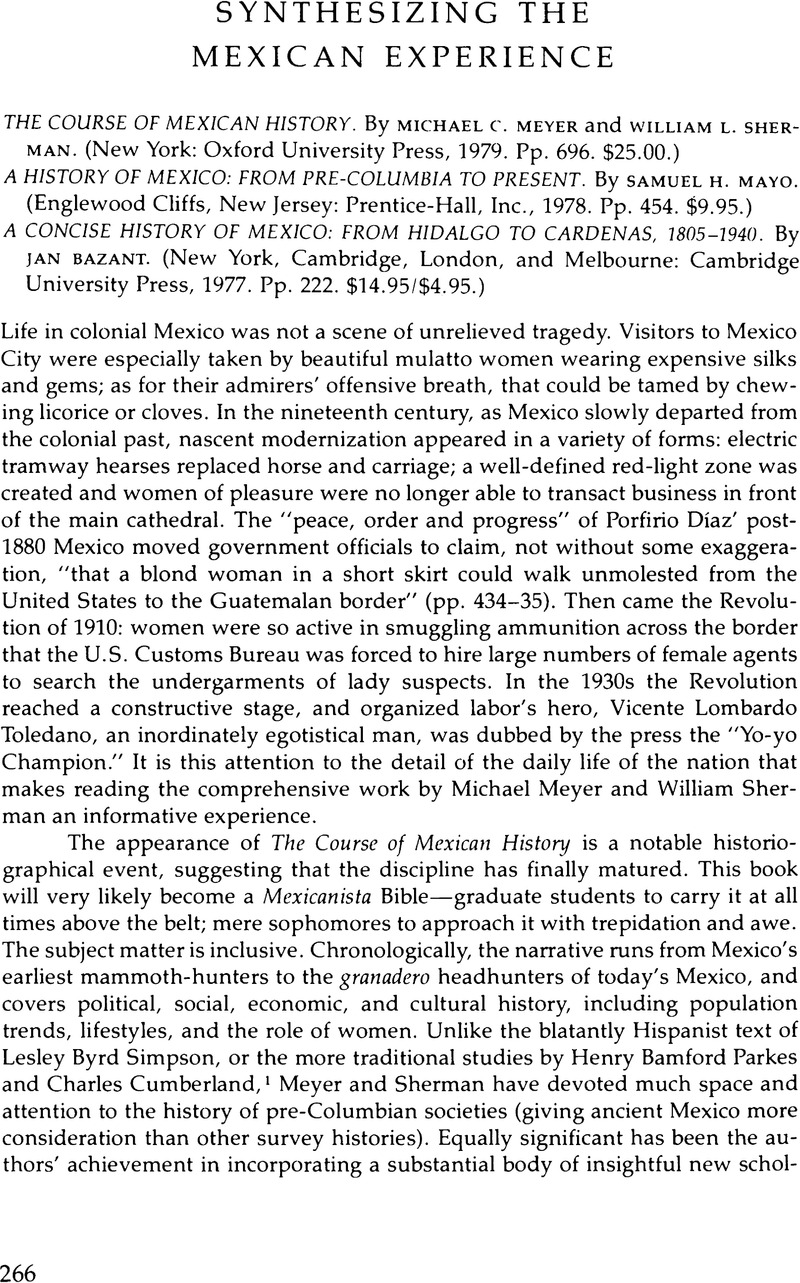No CrossRef data available.
Published online by Cambridge University Press: 24 October 2022

1. Simpson, Many Mexicos (Berkeley and Los Angeles: University of California Press, 1941, 1946, 1952, 1960, 1969); Parkes, A History of Mexico (Boston: Houghton Mifflin Company, 1938, 1950, 1960); Cumberland, Mexico. The Struggle for Modernity (London, Oxford, & New York: Oxford University Press, 1968). Unlike these American counterparts, the work recently released by El Colegio de México entitled A Compact History of Mexico (Mexico, 1974) by Daniel Cosío Villegas and others treats ancient Mexico most adequately given the limitations of space in a brief history.
2. In one brief section on the Porfiriato, Meyer and Sherman introduce several new ideas, each of which is a revision of past historical thinking. For example (pp. 437, 441, and 455–56): Manuel González was not a puppet of Porfirio Díaz, and he actively encouraged the developmental process; the científicos were not all orthodox Comteans—they did not have a monolithic philosophical framework; the rurales were neither harsh nor efficient; and there is a definite correlation between agrarian protests and railroads. The works cited by Meyer and Sherman are: Donald M. Coerver, “The Porfirian Interregnum: The Presidency of Manuel González of Mexico, 1880–1884” (Ph.D. Dissertation, Tulane University, 1972); William D. Raat, “Ideas and Society in Don Porfirio's Mexico,” The Americas 30 (1973): 32–53; Paul Vanderwood, “Mexico: The Porfirian Rurales,” paper presented at Thirty-Eighth Annual Meeting of the Southern Historical Association, 17 November 1972; John Coatsworth, “Railroads, Landholding, and Agrarian Protest in the Early Porfiriato,” Hispanic American Historical Review 54 (1974): 55–57.
3. See Michael Harner, “The Enigma of Aztec Sacrifice,” Natural History (April 1977): 47–51; and “The Ecological Basis for Aztec Sacrifice,” American Ethnologist 4 (February 1977): 117–35. See also the criticism of Harner in an article by Peter T. Furst in the New York Times, 3 March 1977.
4. See William T. Sanders and Barbara J. Price, Mesoamerica: The Evolution of a Civilization (New York: Random House, 1968).
5. Sabloff and Rathje, “The Rise of a Maya Merchant Class,” Scientific American 233 (October 1975): 72–82.
6. Lockhart, The Men of Cajamarca: A Social and Biographical Study of the First Conquerors of Peru (Austin: University of Texas Press, 1972).
7. John K. Chance and William B. Taylor, “Estate and Class in a Colonial City: Oaxaca in 1792,” Comparative Studies in Society and History 19 (October 1977): 454–87; and Chance, Race and Class in Colonial Oaxaca (Stanford, Cal.: Stanford University Press, 1978).
8. John Womack, Jr., “The Mexican Economy During the Revolution, 1910–1920: Historiography and Analysis,” Marxist Perspectives 1 (Winter 1978): 80–123.
9. Johnson, Heroic Mexico: The Narrative History of a Twentieth-Century Revolution (Garden City, N.Y.: Doubleday & Company, 1968).
10. Hellman, Mexico in Crisis (New York: Holmes & Meier Publishers, Inc., 1978).